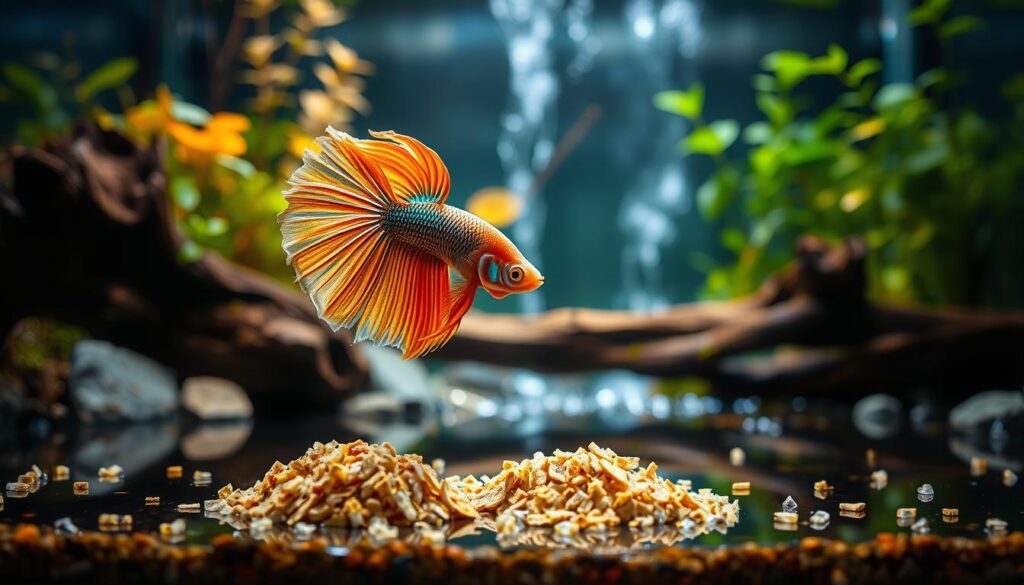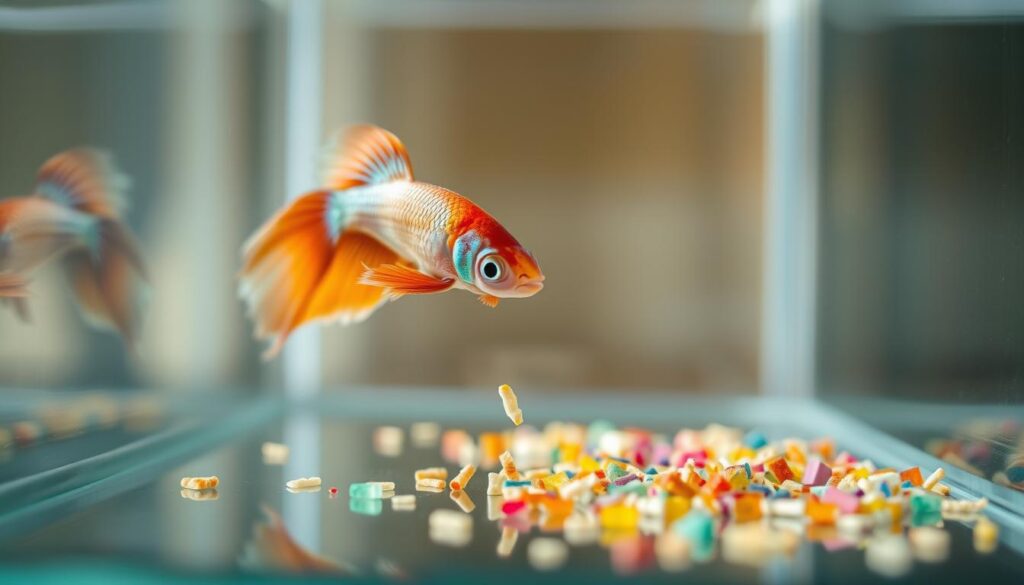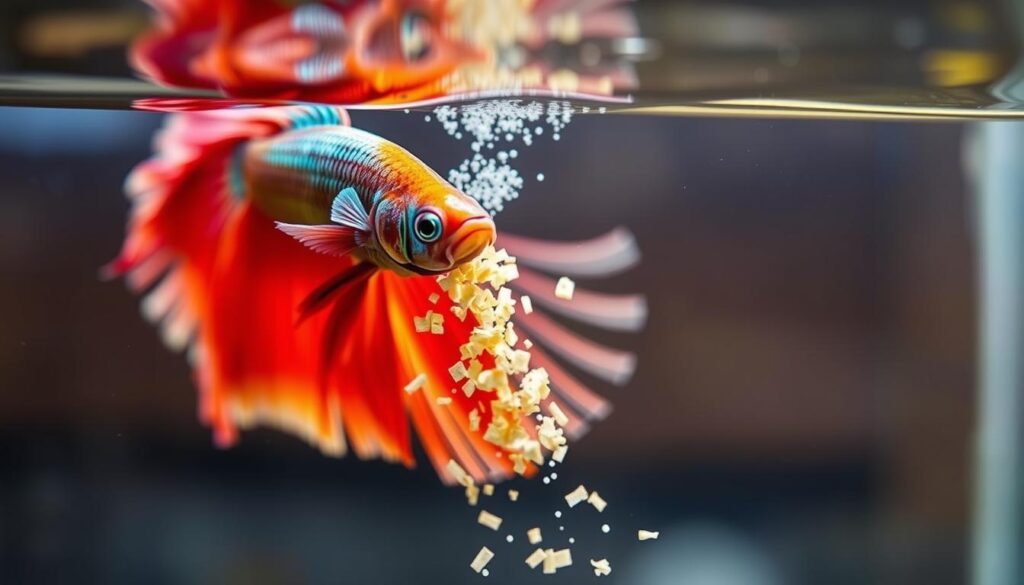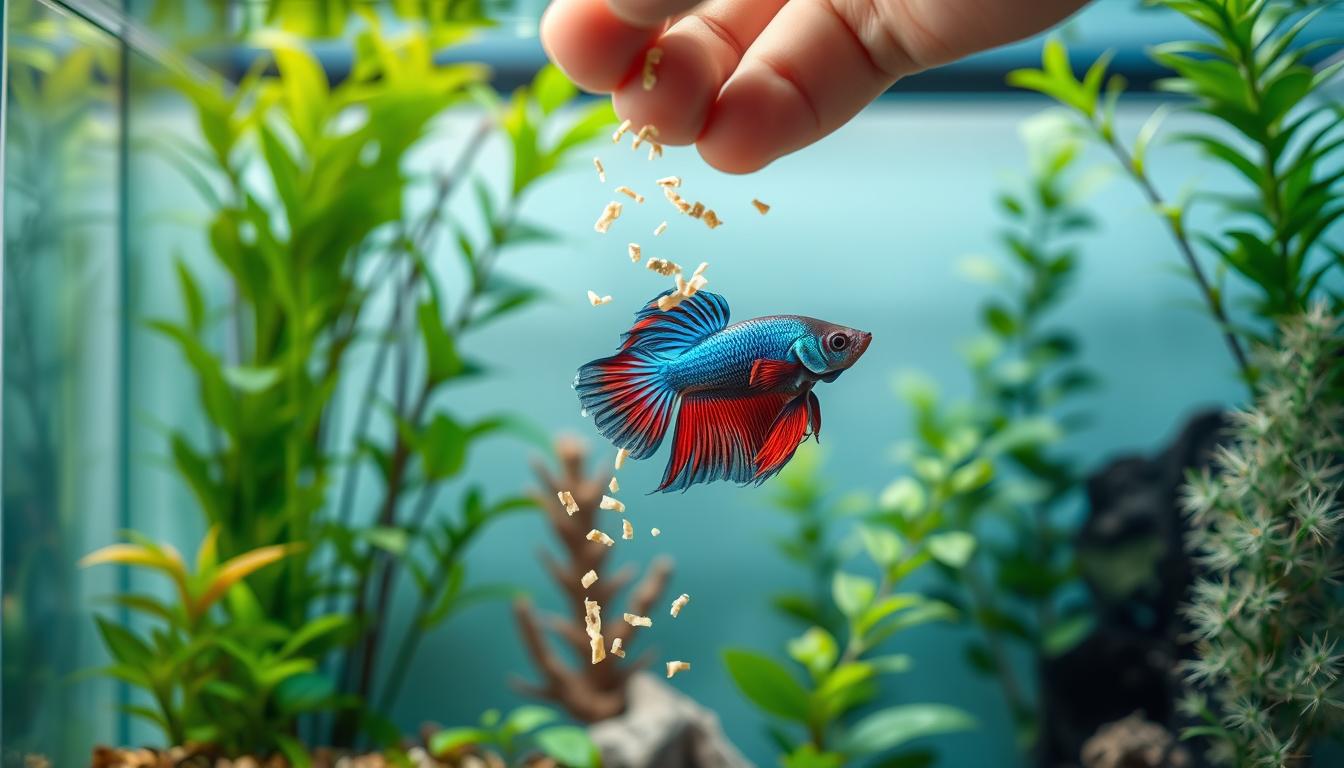Feeding your Betta fish the right way is key to keeping it active, colorful, and healthy. But one common question among Betta owners is:
How often do you feed a Betta fish flakes?
While flakes can be a convenient option, feeding too much or too often can lead to bloating, constipation, or even serious health problems. On the flip side, underfeeding can leave your Betta weak and stressed.
In this guide, we’ll break down how often do you feed a Betta fish flakes, how much to offer at each meal, and some smart tips to keep your Betta on a healthy diet.
Feeding your betta fish the right amount is crucial for their health and happiness. Feeding betta fish flakes twice a day is generally recommended, but it’s essential to understand the nuances of their dietary needs to keep them thriving.
In this article, we’ll dive into the details of feeding betta fish flakes, helping you create a betta fish feeding schedule that works best for you and your pet.
Key Takeaways
- Feed your betta fish flakes twice a day for optimal health.
- Avoid overfeeding to prevent common health issues.
- Understand the dietary needs of your betta fish.
- Create a betta fish feeding schedule that suits you and your pet.
- Monitor your betta’s health and adjust feeding accordingly.
Understanding Betta Fish Nutritional Requirements
Understanding what betta fish eat in the wild is key to providing them with the right nutrition in captivity. In their natural habitat, betta fish are carnivores, feeding on insects and insect larvae. This natural diet gives us clues about their nutritional needs.
Natural Feeding Habits in the Wild
In the wild, betta fish inhabit slow-moving waters where they feed on small insects, larvae, and even tiny crustaceans. Their diet is rich in protein, which is essential for their growth and survival. This carnivorous diet is a crucial aspect of their natural feeding habits.
Essential Nutrients for Captive Bettas
Captive betta fish require a diet that mirrors their natural nutritional intake as closely as possible. Their diet should be rich in certain nutrients to keep them healthy.
Protein Requirements
Betta fish need a diet high in protein. Protein-rich foods help in maintaining their health and vibrant colors. Look for betta fish food that contains a significant amount of protein from animal sources.
Vitamin and Mineral Needs
Apart from protein, betta fish also require vitamins and minerals. These micronutrients are vital for various bodily functions, including immune response and overall health. A balanced diet that includes these nutrients is crucial.
| Nutrient | Importance | Food Sources |
|---|---|---|
| Protein | Essential for growth and health | Insects, larvae, commercial betta flakes |
| Vitamin C | Boosts immune system | Freeze-dried foods, vitamin-enriched flakes |
| Calcium | Important for bone health | Crustaceans, mineral-enriched foods |
By understanding and meeting these nutritional needs, you can ensure your betta fish lead a healthy and happy life. Choosing the right betta fish diet flakes that are rich in protein, vitamins, and minerals is a crucial step in their care.
How Often Do You Feed a Betta Fish Flakes
Feeding your betta fish flakes can be a bit tricky, but don’t worry, we’ve got you covered! The key is to find a balance that keeps your betta happy and healthy. So, how often should you feed your betta fish flakes? The answer depends on several factors, including your fish’s age, size, and activity level.
Ideal Daily Feeding Schedule
For most betta fish, feeding once or twice a day is sufficient. But how do you decide which is best for your finned friend?
Once vs. Twice Daily Feeding
Feeding your betta fish once a day can be a good option if you have a busy schedule. However, dividing their daily ration into two meals can help maintain their energy levels throughout the day. On the other hand, feeding twice a day might lead to overfeeding if not managed properly.
Weekend and Holiday Considerations
Don’t forget about weekends and holidays! You can stick to your betta’s regular feeding schedule, even on weekends. If you’re away, consider using an automatic betta feeder to ensure your fish gets fed on time.
Adjusting Frequency Based on Fish Age and Activity Level
Young, active betta fish may require more frequent feeding, while older or less active betta fish might need less. Observe your betta’s behavior and adjust their feeding schedule accordingly. For instance, if your betta is very active, you might need to feed them twice a day.

Proper Portion Control for Betta Fish Flakes
Feeding your betta fish the right amount of flakes is crucial for their health and happiness! Overfeeding can lead to water quality issues and health problems, so it’s essential to get the portion size just right.
The “Two-Minute Rule” for Feeding
A simple way to determine the right amount of food is by using the “two-minute rule.” This means providing enough flakes for your betta to consume within two minutes. Start with a small amount and adjust accordingly. If your betta finishes the food in under a minute, you can give a bit more!
Visual Guide to Appropriate Flake Portions
Another way to gauge the right amount is by comparing it to your betta’s eye size. A good rule of thumb is to feed an amount equivalent to the size of your betta’s eye. This visual cue helps prevent overfeeding and ensures your betta gets just enough to eat.
One of the most common mistakes betta owners make is overfeeding. So, how can you avoid this? Be mindful of your betta’s appetite and don’t feed them more than they can consume in one sitting. Also, avoid feeding them too frequently, as this can lead to digestive issues.
Signs Your Betta Needs More Food
If your betta seems lethargic or is constantly swimming near the surface, it might be a sign that they need more food. However, before increasing the amount, make sure to check the water quality and other environmental factors that might be affecting their behavior.
Selecting High-Quality Betta Fish Flakes
Not all betta fish flakes are created equal, and we’re about to dive into what makes a high-quality flake. When choosing the best food for your betta fish, it’s crucial to consider the ingredients and nutritional value of the flakes.
Essential Ingredients in Premium Flakes
High-quality betta fish flakes should contain protein-rich ingredients as the main component. Let’s break down the key elements to look for:
Protein Content Analysis
Look for flakes with a high protein content, typically derived from sources like fish meal, shrimp meal, or krill meal. A good flake should have at least 40% protein content.
Beneficial Additives and Supplements
Some premium flakes include beneficial additives such as vitamins, minerals, and probiotics to support your betta’s overall health. These additives can enhance digestion and boost the immune system.
Top-Rated Betta Flake Brands in the US
Here are some top-rated betta flake brands that meet our criteria for high-quality ingredients:
| Brand | Protein Content | Notable Additives |
|---|---|---|
| Hikari | 45% | Vitamin C, probiotics |
| API | 42% | Mineral supplements |
| Tetra | 40% | Color enhancers |
By choosing a high-quality flake from reputable brands, you can ensure your betta is getting the nutrients it needs to thrive.

Flakes vs. Alternative Betta Foods
While flakes are a staple in many betta diets, they’re not the only option – let‘s explore some alternatives! Betta fish can benefit from a varied diet that includes pellets, freeze-dried foods, and live or frozen foods.
Comparing Flakes to Pellets and Freeze-Dried Options
Pellets and freeze-dried foods offer different nutritional profiles compared to flakes. Pellets, for instance, can reduce waste and provide a more consistent nutrient intake. Freeze-dried foods, on the other hand, can be rich in protein and offer a different texture that betta fish find appealing.

When to Supplement with Live or Frozen Foods
Live or frozen foods like bloodworms and brine shrimp can be a great treat for your betta. These foods provide essential nutrients and can stimulate your betta’s natural hunting behavior. Supplementing with live or frozen foods can be done occasionally to add variety to their diet.
Bloodworms and Brine Shrimp as Treats
Bloodworms and brine shrimp are nutrient-rich foods that can be given as treats. They’re high in protein and can help keep your betta’s diet interesting.
Creating a Varied Diet Schedule
To create a varied diet schedule, you can rotate between flakes, pellets, and live or frozen foods. For example, you can feed flakes or pellets daily and supplement with live or frozen foods once or twice a week. This variety ensures your betta gets a broad spectrum of nutrients.
Developing a Balanced Feeding Routine with Flakes
Creating a balanced feeding routine for your betta fish is crucial for their overall health and wellbeing. A well-balanced diet ensures your betta stays healthy, vibrant, and active. Let’s explore how to create a feeding plan that incorporates flakes as the main staple.
Read Also Amano Shrimp and Betta Fish: Tips for Successful Cohabitation
Creating a Weekly Meal Plan for Your Betta
To keep your betta fish thriving, you should develop a weekly meal plan. Start by deciding on the number of days you’ll feed flakes and the days you’ll supplement with other foods. For example, you can feed flakes 4-5 days a week and supplement with live or frozen foods 2-3 days a week.
- Monday: Flakes
- Tuesday: Flakes
- Wednesday: Supplement with live food
- Thursday: Flakes
- Friday: Flakes
- Saturday: Supplement with frozen food
- Sunday: Flakes
Rotating Food Types for Complete Nutrition
Rotating food types is essential to provide your betta with a balanced diet. Flakes can be the main staple, but supplementing with other foods like pellets, freeze-dried foods, or live foods will ensure your betta gets all the necessary nutrients.
Sample Feeding Schedules
Here’s a sample feeding schedule you can follow:
| Day | Food Type |
|---|---|
| Monday | Flakes |
| Tuesday | Pellets |
Seasonal Adjustments to Feeding
Adjusting your betta’s feeding schedule according to the season can help mimic their natural environment. For instance, during the winter months, you can slightly reduce the frequency of feeding, as betta fish tend to be less active in colder temperatures.

Common Betta Flake Feeding Mistakes to Avoid
Let’s dive into the common errors people make when feeding their betta fish flakes and how to avoid them. Feeding betta fish flakes might seem straightforward, but there are several pitfalls that can affect your pet’s health and well-being.
Overfeeding Consequences: Bloat and Water Quality Issues
Overfeeding is one of the most significant mistakes betta owners make. It can lead to bloat and water quality issues, which can be detrimental to your betta’s health. Overfeeding can cause your betta to suffer from swim bladder problems, making it difficult for them to swim properly.
Swim Bladder Problems from Excess Food
When betta fish are overfed, they can develop swim bladder issues. This condition can cause them to float abnormally or have trouble swimming. It’s a painful condition that can be avoided by controlling the amount of food you give them.
Ammonia Spikes from Uneaten Flakes
Uneaten flakes can decompose, leading to ammonia spikes in the tank. This can be toxic to your betta fish, causing stress and potentially leading to disease. As the saying goes, “A clean tank is a happy tank!”
“The key to a healthy aquarium is maintaining good water quality.”
Improper Flake Storage and Freshness Problems
Improper storage of betta flakes can lead to freshness issues. If the flakes are exposed to air, moisture, or light, they can lose their nutritional value. Always store your betta flakes in a cool, dry place, and check the expiration date to ensure you’re providing the best food for your pet.

Special Feeding Situations for Betta Fish
When life gets complicated, like when your betta fish is under the weather or you’re heading out on vacation, their feeding schedule can become a challenge! Don’t worry, we’ve got you covered. Let’s dive into some special feeding situations and how to handle them.
Feeding During Illness or Recovery
If your betta is sick or recovering, it’s crucial to adjust their diet accordingly. Reduce feeding frequency and offer easily digestible foods like live or frozen foods that are rich in nutrients. For instance, you can try feeding them brine shrimp or bloodworms as a nutritious treat.
- Monitor their appetite closely
- Avoid overfeeding, as it can exacerbate water quality issues
- Consider a fasting day to help your betta recover
Vacation Feeding Options and Automatic Feeders
Going on vacation doesn’t mean your betta’s feeding schedule has to suffer. You have a couple of options to ensure they’re well-fed while you’re away.
Pros and Cons of Vacation Feeding Blocks
Vacation feeding blocks can be a convenient option, but they have their pros and cons.
| Pros | Cons |
|---|---|
| Easy to use | Can cause water quality issues |
| Provide a steady food supply | May not be suitable for all betta fish |
Setting Up Reliable Automatic Feeders
Automatic feeders are another great option for vacation feeding. They allow you to program feeding times and control portion sizes. When choosing an automatic feeder, consider one that’s reliable and easy to use. Make sure to test it before you leave to avoid any issues!
By considering these special feeding situations, you can ensure your betta fish remains healthy and happy, even when life gets complicated.
Monitoring Health Through Feeding Behavior
The way your betta fish responds to feeding can be a significant indicator of their health status. By paying close attention to your betta’s feeding behavior, you can catch potential health issues early and ensure they’re getting the nutrients they need.
Normal vs. Concerning Appetite Changes
It’s normal for betta fish to have varying appetites from day to day. However, a persistent loss of appetite or a sudden increase in hunger can be concerning. “A change in appetite is often the first sign of illness in betta fish,” says an experienced aquarist. If you notice any unusual eating habits, it’s essential to investigate further.
Using Feeding Time for Health Assessments
Feeding time provides a great opportunity to assess your betta’s overall health. Look for signs of illness or stress, such as lethargy, labored breathing, or visible injuries. Checking your betta during feeding can help you identify issues before they become severe.
Physical Signs to Watch For
- Discoloration or fading of colors
- Visible spots, lesions, or fungal growth
- Lethargy or loss of energy
- Clamped fins or unusual swimming patterns
When to Consult a Fish Veterinarian
If you notice any persistent or severe symptoms, it’s time to consult a fish veterinarian. They can provide guidance on treating common betta fish ailments and help you develop a plan to get your betta back to optimal health. Establishing a proper betta fish flake food schedule is also crucial for maintaining their health.
By monitoring your betta’s feeding behavior and being aware of the signs of potential health issues, you can take proactive steps to ensure they lead a long and healthy life. This includes paying attention to the feeding betta fish flakes frequency and ensuring their betta fish diet flakes are of high quality.
Training Your Betta to Follow a Flake Feeding Schedule
Training your betta fish to follow a flake feeding schedule can be a fun and rewarding experience! By establishing a consistent feeding routine, you can help your betta thrive and strengthen your bond with them.
Conditioning Techniques for Regular Feeding
To condition your betta to a flake feeding schedule, start by feeding them at the same time every day. Use a high-quality flake food that’s rich in nutrients, and make sure to provide the right amount – just enough for them to consume within 2 minutes. You can also try tapping on the glass near the food to create a visual cue, helping your betta associate the sound with feeding time!
Building a Feeding Relationship with Your Betta
As you stick to your feeding schedule, you’ll start to notice your betta becoming more responsive to your presence. They might even swim up to greet you or perform tricks to get your attention! By being consistent and engaging during feeding times, you can build a strong feeding relationship with your betta, making mealtime a highlight of their day.
Conclusion
By now, you should have a better understanding of how to feed your betta fish flakes and create a balanced betta fish feeding schedule. Remember, a well-fed betta is a happy and healthy one!
To keep your betta thriving, stick to a consistent feeding routine and choose the best food for betta fish flakes. You might be wondering, “how often do you feed a betta fish flakes?” The answer lies in finding the right balance – not too much, not too little.
As you continue on your betta care journey, keep in mind that a varied diet and proper nutrition are key to a long and healthy life for your finned friend. With the right knowledge and a little practice, you’ll become a betta feeding pro in no time!

